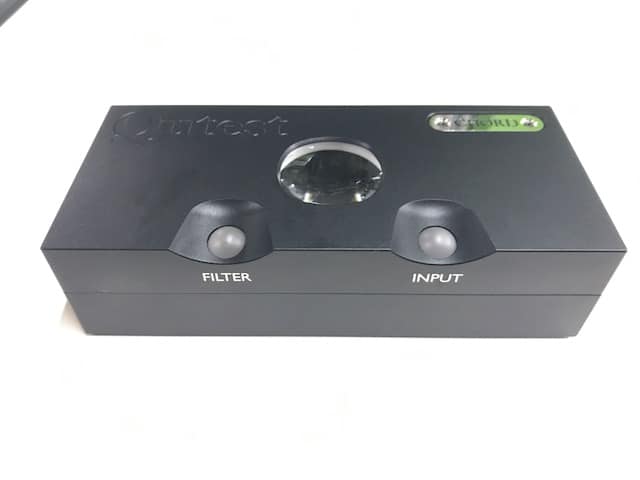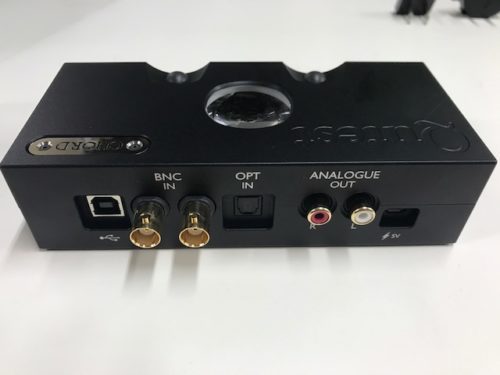The idea behind Qutest was to use all the technology in Chord’s Hugo 2, but design it as a DAC only unit. If you’re new to Chord’s world, this stuff can be confusing. When first reading up on this new device, it’s easy to become overwhelmed by all the tech talk. Sure, Qutest’s capabilities are extensive. Advanced filters, 5V Micro USB powering, changeable output voltage, etc. We will delve into this a bit below. But in its simplest terms, it’s a pure DAC, designed exclusively for home use. Listen to music from your computer or any coaxial (or optical) based home entertainment equipment, and hook it up to your amp, preamp or active speakers via analogue output.
Look and Feel
The Qutest has a beautifully simple aesthetic design. Only two buttons control the many features.The Qutest is quite a bit heavier than its predecessor, the 2Qute. Chord’s designers were realizing that the weight of all the connections were practically lifting the the 2Qute off the table surface. The added weight also lends itself to the general solidity of the electronics with the DAC. So, heavy is good.
When you turn on the Qutest, it lights up a like a discotech. It’s got a cool viewing glass that not only shows you the internal design but also, in classic Chord fashion, displays sample rates through various colors. The two buttons also have different colored lights depending on your chosen filter and input.


Qutest VS Hugo2
For those of you who are already familiar with the Hugo 2, I’ll outline some differences and similarities that have been implemented on the Qutest. I should first mention that the DACs themselves are identical.
For my ADD friends who like to skim articles, let me repeat: Hugo2 is a DAC-AMP combo. Qutest is a pure DAC.
The second major difference between the two devices is that the Qutest will adjust the output voltage to suit different preamps. Pre-amps tend to have sensitivity issues and sometimes overload at certain inputs. Simply press the two buttons at the same time, and you can set the device to 1V, 2V or 3V.
Another difference is the galvanically isolated USB-B input, which means it is designed to be connected to a fixed system.
It also has dual BNC inputs so that you can connect it straight to an M-scaler, as used in the Chord Blu Mkll upscaling CD transport. (What is that, you ask? It’s like a super-duper CD player without an internal DAC. Instead, it’s made to work with an external, dedicated DAC, like the Qutest.) M-scaler technology is apparently the future of audio, so BNC inputs are a nice feature to have if you plan on living for at least 10 more years.
You get the same type of filters on the Qutest as you do on the Hugo 2: Incisive neutral, incisive neutral HF roll-off, warm and warm HF roll-off. On of the two buttons on the DAC (labeled: Filter) glows different colors depending on the filter selected. For a more detailed explanation about these filters and what they do, check out Chord Hugo 2 Filters Explained for the Common Audiophile.
One thing that the Qutest is missing, however, is the Bluetooth capability that you get on the Hugo 2. Hmm…Bummer.

Other Improvements
Qutest uses the snazziest FPGA technology and most advanced Watts Transient Aligned filters to make it sound even better than the 2Qute. It’s got more range, noise reduction, accuracy and tap length. Tap length…Hmm. Listen, it sounds better. Let’s leave it at that.
Sound
Switching through the four filters, you get two basic types of sound. Incisive neutral and warm. The incisive neutral filter conveys an incredibly clear and detailed sound, while maintaining a smooth and sweet feeling that I’m a sucker for. The coherence is just divine. Switch it to warm, and it loses a tiny bit of crispness and neutrality, but compensates with a soft and emotive tonal character that gives recordings that extra bit of color. It’s spacious and, for sure, luxurious. All in all, a beautiful listening experience.
Summary
Most of us might agree that the Chord Hugo 2 provides superior sound and features for the price when comparing it to other brands in this echelon. The Qutest sounds just as good for a whopping 800 bucks less. But of course, you’re missing a headphone amp and Bluetooth capability, as well a rechargeable battery. If you don’t need any of those things, and pure, unadulterated gold is your quest, then this is definitely the Chord model you should go for.
You can find this DAC for the best price at:
Audio 46: Chord Qutest DAC Use our promo code “majorhifi” to get a 10% discount
MajorHiFi may receive commission from retail offers.
Specifications
Inputs:
1x Optical TOSLink 24-bit/192kHz-capable
2x BNC coaxial input 24-bit/384kHz-capable (dual data mode up to 768kHz for M-Scaler operation)
1x HD galvanically isolated USB-B input 32-bit/768kHz and DSD512-capable
Outputs:
1x (pair) stereo analogue outputs: 1, 2 and 3V RMS
Frequency response: 20-20 kHz +/- 0.2dB
Tap-length: 49,152
Dynamic range 124 dB AWt
THD: 0.0001% 1 kHz 2.5V RMS 300 ohms
THD and noise at 2.5v RMS ref 3V: -117dB 300 ohms AWt
Channel sep 138 dB at 1kHz 300 ohms
Galvanically isolated USB
MAJORHIFI may receive commissions from retail offers.









